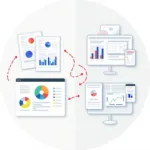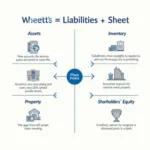TOEIC Reading Practice Test: Analyzing Annual Profit SummariesPart 1: Incomplete Sentences
-
The company’s annual profit summary showed a significant ____ in revenue compared to the previous year.
A. increase
B. decrease
C. stability
D. fluctuation
-
The CFO presented a ____ analysis of the company’s financial performance during the annual shareholders’ meeting.
A. comprehensive
B. brief
C. vague
D. biased
-
Despite economic challenges, the firm managed to ____ a steady profit margin throughout the fiscal year.
A. maintain
B. decrease
C. eliminate
D. exaggerate
-
The annual report highlighted the need to ____ operating costs to improve overall profitability.
A. increase
B. stabilize
C. reduce
D. maximize
-
Investors were pleased to see a ____ increase in the company’s net income over the past three years.
A. gradual
B. sudden
C. minimal
D. negative
-
The financial statements ____ a clear picture of the company’s economic health and growth potential.
A. obscured
B. provided
C. distorted
D. minimized
-
The board of directors ____ the CEO’s strategy for improving profit margins in the coming year.
A. rejected
B. approved
C. questioned
D. ignored
-
The company’s profit summary revealed a ____ correlation between marketing expenditure and sales growth.
A. negative
B. neutral
C. positive
D. insignificant
-
Analysts ____ the company’s strong performance to its innovative product line and efficient cost management.
A. attributed
B. discredited
C. overlooked
D. exaggerated
-
The annual report ____ several key factors that contributed to the company’s record-breaking profits.
A. omitted
B. highlighted
C. misrepresented
D. underestimated
-
Shareholders expressed concern over the ____ profit margins in the company’s overseas operations.
A. declining
B. stable
C. improving
D. fluctuating
-
The CEO emphasized the importance of ____ investments in research and development to maintain the company’s competitive edge.
A. reducing
B. eliminating
C. sustaining
D. postponing
-
The profit summary indicated a need to ____ the company’s product portfolio to reduce dependence on a single market segment.
A. narrow
B. maintain
C. diversify
D. simplify
-
The financial report ____ the impact of recent acquisitions on the company’s overall profitability.
A. ignored
B. exaggerated
C. quantified
D. minimized
-
Experts predict a ____ outlook for the industry, based on current market trends and economic indicators.
A. pessimistic
B. optimistic
C. neutral
D. uncertain
-
The company’s profit margins ____ consistently over the past five years, indicating strong financial management.
A. declined
B. fluctuated
C. stagnated
D. improved
-
The annual summary ____ the need for increased investment in employee training and development programs.
A. overlooked
B. emphasized
C. disputed
D. exaggerated
-
The financial statements were ____ by an independent auditing firm to ensure accuracy and compliance with accounting standards.
A. prepared
B. manipulated
C. verified
D. simplified
-
The company’s strong cash flow position ____ its ability to fund future growth initiatives without relying on external financing.
A. undermined
B. highlighted
C. questioned
D. ignored
-
The profit summary revealed a ____ increase in operating expenses, prompting management to implement cost-cutting measures.
A. marginal
B. substantial
C. negligible
D. gradual
-
Analysts ____ the company’s ability to maintain its market leadership position in the face of increasing competition.
A. praised
B. criticized
C. questioned
D. ignored
-
The annual report ____ the company’s commitment to sustainable practices and their positive impact on long-term profitability.
A. undermined
B. highlighted
C. overlooked
D. exaggerated
-
The profit margins in the company’s e-commerce division showed significant ____ compared to its traditional retail operations.
A. decline
B. stability
C. improvement
D. fluctuation
-
The financial summary ____ the need for strategic partnerships to enter new markets and drive future growth.
A. dismissed
B. emphasized
C. overlooked
D. misrepresented
-
The company’s annual profit growth ____ industry averages, positioning it as a top performer in its sector.
A. matched
B. underperformed
C. outpaced
D. ignored
-
The report ____ several potential risks that could impact the company’s profitability in the coming year.
A. concealed
B. exaggerated
C. identified
D. dismissed
-
The CEO ____ the importance of digital transformation in driving future revenue growth and improving operational efficiency.
A. downplayed
B. questioned
C. emphasized
D. overlooked
-
The profit summary showed a ____ return on investment for the company’s recent expansion into emerging markets.
A. negative
B. stable
C. fluctuating
D. positive
-
The annual report ____ the company’s efforts to streamline its supply chain, resulting in significant cost savings.
A. criticized
B. ignored
C. highlighted
D. misrepresented
-
Shareholders expressed ____ with the company’s dividend policy, given its strong financial performance.
A. disappointment
B. satisfaction
C. indifference
D. confusion
The company’s annual profit summary showed a significant ____ in revenue compared to the previous year.
A. increase
B. decrease
C. stability
D. fluctuation
The CFO presented a ____ analysis of the company’s financial performance during the annual shareholders’ meeting.
A. comprehensive
B. brief
C. vague
D. biased
Despite economic challenges, the firm managed to ____ a steady profit margin throughout the fiscal year.
A. maintain
B. decrease
C. eliminate
D. exaggerate
The annual report highlighted the need to ____ operating costs to improve overall profitability.
A. increase
B. stabilize
C. reduce
D. maximize
Investors were pleased to see a ____ increase in the company’s net income over the past three years.
A. gradual
B. sudden
C. minimal
D. negative
The financial statements ____ a clear picture of the company’s economic health and growth potential.
A. obscured
B. provided
C. distorted
D. minimized
The board of directors ____ the CEO’s strategy for improving profit margins in the coming year.
A. rejected
B. approved
C. questioned
D. ignored
The company’s profit summary revealed a ____ correlation between marketing expenditure and sales growth.
A. negative
B. neutral
C. positive
D. insignificant
Analysts ____ the company’s strong performance to its innovative product line and efficient cost management.
A. attributed
B. discredited
C. overlooked
D. exaggerated
The annual report ____ several key factors that contributed to the company’s record-breaking profits.
A. omitted
B. highlighted
C. misrepresented
D. underestimated
Shareholders expressed concern over the ____ profit margins in the company’s overseas operations.
A. declining
B. stable
C. improving
D. fluctuating
The CEO emphasized the importance of ____ investments in research and development to maintain the company’s competitive edge.
A. reducing
B. eliminating
C. sustaining
D. postponing
The profit summary indicated a need to ____ the company’s product portfolio to reduce dependence on a single market segment.
A. narrow
B. maintain
C. diversify
D. simplify
The financial report ____ the impact of recent acquisitions on the company’s overall profitability.
A. ignored
B. exaggerated
C. quantified
D. minimized
Experts predict a ____ outlook for the industry, based on current market trends and economic indicators.
A. pessimistic
B. optimistic
C. neutral
D. uncertain
The company’s profit margins ____ consistently over the past five years, indicating strong financial management.
A. declined
B. fluctuated
C. stagnated
D. improved
The annual summary ____ the need for increased investment in employee training and development programs.
A. overlooked
B. emphasized
C. disputed
D. exaggerated
The financial statements were ____ by an independent auditing firm to ensure accuracy and compliance with accounting standards.
A. prepared
B. manipulated
C. verified
D. simplified
The company’s strong cash flow position ____ its ability to fund future growth initiatives without relying on external financing.
A. undermined
B. highlighted
C. questioned
D. ignored
The profit summary revealed a ____ increase in operating expenses, prompting management to implement cost-cutting measures.
A. marginal
B. substantial
C. negligible
D. gradual
Analysts ____ the company’s ability to maintain its market leadership position in the face of increasing competition.
A. praised
B. criticized
C. questioned
D. ignored
The annual report ____ the company’s commitment to sustainable practices and their positive impact on long-term profitability.
A. undermined
B. highlighted
C. overlooked
D. exaggerated
The profit margins in the company’s e-commerce division showed significant ____ compared to its traditional retail operations.
A. decline
B. stability
C. improvement
D. fluctuation
The financial summary ____ the need for strategic partnerships to enter new markets and drive future growth.
A. dismissed
B. emphasized
C. overlooked
D. misrepresented
The company’s annual profit growth ____ industry averages, positioning it as a top performer in its sector.
A. matched
B. underperformed
C. outpaced
D. ignored
The report ____ several potential risks that could impact the company’s profitability in the coming year.
A. concealed
B. exaggerated
C. identified
D. dismissed
The CEO ____ the importance of digital transformation in driving future revenue growth and improving operational efficiency.
A. downplayed
B. questioned
C. emphasized
D. overlooked
The profit summary showed a ____ return on investment for the company’s recent expansion into emerging markets.
A. negative
B. stable
C. fluctuating
D. positive
The annual report ____ the company’s efforts to streamline its supply chain, resulting in significant cost savings.
A. criticized
B. ignored
C. highlighted
D. misrepresented
Shareholders expressed ____ with the company’s dividend policy, given its strong financial performance.
A. disappointment
B. satisfaction
C. indifference
D. confusion
![]() Analyzing Annual Profit Summaries for TOEIC Reading
Analyzing Annual Profit Summaries for TOEIC Reading
Part 2: Text Completion
Text 1:
The annual profit summary is a crucial document for any company, providing insights into its financial health and performance. When analyzing these summaries, it’s important to consider several key factors. First, ____ the overall revenue growth compared to previous years. This indicates whether the company is expanding its market share or facing challenges in sales. Next, examine the ____ between revenue and expenses to understand the company’s profitability. A widening gap suggests improved efficiency, while a narrowing one may indicate rising costs or pricing pressures. Additionally, pay attention to the ____ of different business segments or product lines. This can reveal which areas are driving growth and which may need attention. Finally, consider the company’s ____ position, including cash flow and debt levels, to assess its financial stability and ability to fund future growth initiatives.
-
A. ignore
B. overlook
C. assess
D. minimize -
A. relationship
B. disconnect
C. similarity
D. conflict -
A. elimination
B. consolidation
C. performance
D. reduction -
A. market
B. competitive
C. operational
D. financial
Text 2:
Effective profit analysis requires a thorough understanding of various financial metrics and ratios. One key indicator is the gross profit margin, which ____ the percentage of revenue retained after accounting for the cost of goods sold. A higher gross profit margin generally indicates better efficiency in production or purchasing. Another important metric is the operating profit margin, which ____ how much profit a company makes from its core business operations. This figure excludes interest and taxes, providing a clearer picture of operational efficiency. The net profit margin, on the other hand, ____ the percentage of revenue that translates into profit after all expenses, including taxes and interest, are deducted. Lastly, the return on equity (ROE) ____ how effectively a company uses its shareholders’ investments to generate profits. A higher ROE suggests better utilization of capital and is often attractive to potential investors.
-
A. minimizes
B. represents
C. ignores
D. exaggerates -
A. overlooks
B. measures
C. reduces
D. increases -
A. calculates
B. eliminates
C. overlooks
D. maximizes -
A. ignores
B. minimizes
C. indicates
D. exaggerates
Text 3:
When reviewing an annual profit summary, it’s essential to consider both quantitative and qualitative factors. While numbers provide concrete data, the narrative sections of the report often ____ valuable context and insights. Pay attention to management’s discussion of market trends, competitive pressures, and strategic initiatives. These qualitative factors can ____ future performance and help explain current results. Additionally, it’s important to ____ the company’s performance against industry benchmarks and competitors. This comparative analysis can reveal whether the company is outperforming or lagging behind its peers. Lastly, don’t overlook the importance of ____ factors such as economic conditions, regulatory changes, and technological advancements that may impact the company’s profitability in the future.
-
A. obscure
B. offer
C. minimize
D. exaggerate -
A. ignore
B. predict
C. undermine
D. stabilize -
A. compare
B. ignore
C. exaggerate
D. minimize -
A. irrelevant
B. internal
C. external
D. financial
Text 4:
Analyzing profit trends over time is crucial for understanding a company’s financial trajectory. Look for ____ patterns in revenue growth, cost management, and profit margins. Consistent improvement across these areas typically indicates strong financial management and a solid business model. However, be wary of ____ growth or profit increases that may not be sustainable in the long term. It’s also important to consider the impact of one-time events or ____ factors that may have influenced the company’s profitability. These could include things like asset sales, restructuring costs, or changes in accounting methods. Finally, pay attention to the company’s ____ for future growth and profitability. This forward-looking information can provide valuable insights into management’s strategy and the potential for continued financial success.
-
A. random
B. consistent
C. declining
D. insignificant -
A. steady
B. declining
C. sudden
D. minimal -
A. irrelevant
B. non-recurring
C. permanent
D. typical -
A. disregard
B. criticism
C. outlook
D. history
Answer Key
Part 1: Incomplete Sentences
- A
- A
- A
- C
- A
- B
- B
- C
- A
- B
- A
- C
- C
- C
- B
- D
- B
- C
- B
- B
- C
- B
- C
- B
- C
- C
- C
- D
- C
- B
Part 2: Text Completion
- C
- A
- C
- D
- B
- B
- A
- C
- B
- B
- A
- C
- B
- C
- B
- C
![]() TOEIC Reading Practice: Annual Profit Analysis
TOEIC Reading Practice: Annual Profit Analysis
This TOEIC Reading practice test focuses on the analysis of annual profit summaries, covering key financial concepts and terminology. The questions are designed to test your understanding of financial reporting, business performance metrics, and the ability to interpret complex financial information. By practicing with these questions, you’ll improve your ability to comprehend and analyze business-related texts, which is crucial for success in the TOEIC Reading section.
Remember to pay close attention to context clues, idiomatic expressions, and specific financial terms when answering these questions. Developing a strong grasp of business vocabulary and financial concepts will greatly enhance your performance on the TOEIC test and in real-world business scenarios.




